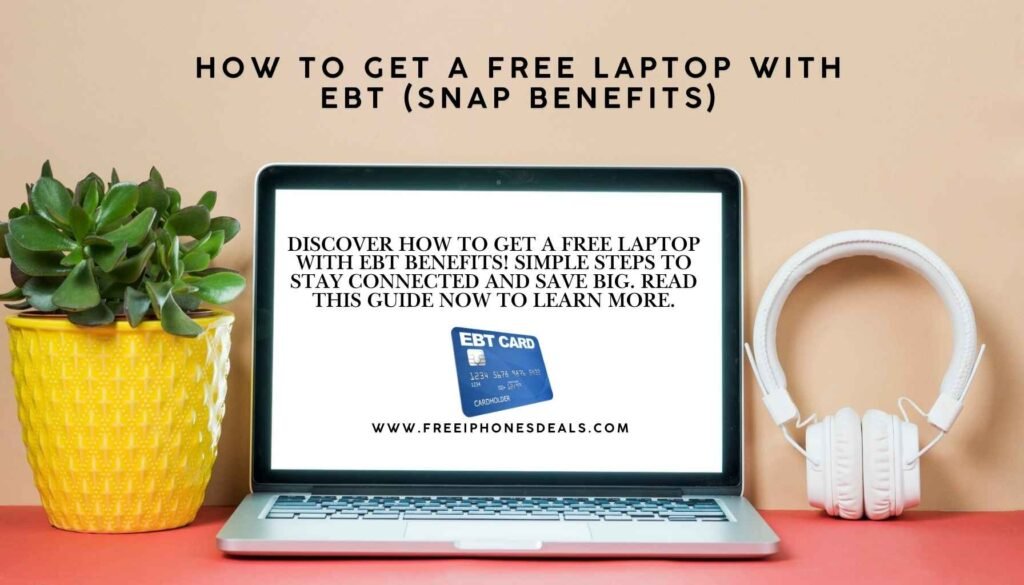The U.S. government and nonprofit groups provide free laptops and other devices. This helps close the digital divide. In the current digital age, having a computer is essential rather than a luxury.

A laptop or tablet can help with online education, job applications, telehealth, and staying in touch with loved ones.
Free Government Laptop programs are becoming crucial. This is especially true for low-income families in the United States. This guide will help you learn how to get a free laptop, tablet, or PC. These devices come from government or nonprofit programs.
ALSO READ: Free Laptop with EBT
Why do they give free laptops?
With the world moving rapidly into the digital age, the digital divide is more evident than ever. Many low-income families still find it hard to afford technology. This puts them at a disadvantage in education, jobs, and healthcare.
The U.S. government sees this gap. They have teamed up with nonprofit groups. Together, they offer free PCs, tablets, and laptops. This program helps make sure every American can access digital tools.
Who is eligible for a free laptop?
Eligibility varies by program, but typically, you may qualify if:
- Your family’s earnings are at or under 135% of the Federal Poverty Guidelines.
- You participate in government assistance programs such as SNAP, Medicaid, SSI, TANF, or Free/Reduced School Lunch.
- You are a student in a low-income household.
- You are a senior or person with disabilities.
- You live in HUD-assisted housing.
Make sure to check the specific requirements of each program before applying.
Government programs providing free laptops:
Several federal and state initiatives help distribute free laptops and tablets to qualifying individuals.
1. Lifeline Assistance Program
- Provides free or discounted internet and devices, including free tablets and laptops.
- Administered by the FCC, available through providers like Assurance Wireless and Safelink.
- Eligibility: Must participate in SNAP, Medicaid, SSI, or other assistance programs.
2. HUD Initiative
- The HUD collaborates with various nonprofit organizations to achieve its goals. They provide free computers to low-income individuals living in public housing.
- Includes digital literacy training for better job opportunities.
3. Digital Equity Initiative
- A federal effort to ensure all Americans have access to affordable technology.
- Provides free government laptops to students and underserved communities.
4. State Education Grants
- Many states offer free laptops for students through school districts.
- Programs like California’s K-12 Digital Equity Grant provide devices to low-income families.
Nonprofit and charitable organizations providing free laptops:
Several nonprofits refurbish and distribute free PCs and laptops to those in need.
1. On It Foundation
- Provides free computers to low-income K-12 students with financial need.
- You need to show proof of enrollment in a free or reduced lunch program.
2. PCs for People
- Offers low-cost and free laptops to eligible individuals.
- You must qualify based on your income or your participation in government assistance programs.
3. Human-I-T
- Refurbishes donated devices and provides free or low-cost laptops to low-income families, veterans, and nonprofits.
4. Everyone On
- Connects low-income families with affordable internet and free or discounted laptops.
- Partners with major tech companies to distribute devices.
State-specific laptop support:
Several states have implemented their own free laptop initiatives.
- California: Offers grants through the Digital Equity program.
- Texas: Some school districts provide laptops to low-income students.
- New York: Community programs offer refurbished computers to residents in need.
- Florida: On It Foundation distributes free computers to students.
Check with your state or local government for specific opportunities.
How to Apply For a Free Government Laptops programs – step by step:
- Check Eligibility: Confirm income or program-based qualifications.
- Find a Program: Choose a government or nonprofit program (Lifeline, PCs for People, etc.).
- Gather Documents: Proof of income, ID, and program participation (SNAP, Medicaid).
- Submit Application: Apply online or via mail.
- Await Confirmation: The process might require several weeks.
- Obtain Device: Qualified individuals receive a complimentary laptop or tablet.
Avoid scams: apply safely:
- Only apply through official government or nonprofit websites.
- Avoid paying upfront fees—legitimate programs do not charge for free devices.
- Verify program legitimacy via the FCC or state education department.
- Contact the organization directly if you have questions.
Additional considerations for free laptop programs:
- Restricted Supply: Typically, the system allocates devices to those who arrive first.
- Refurbished Devices: Most free government PCs have gentle use but remain fully functional.
- Internet Access: Some programs include low-cost internet
Alternative ways to access laptop:
If you don’t qualify for a free government laptop, try:
- Local Libraries: Many offer free computer access.
- School or University Programs: Students often get loaner laptops.
- Employer or Job Training Programs: Some job training initiatives offer laptops.
- You can find affordable laptops at low cost through certified refurbishers in the buyback or refurbished markets.
Impact of the Free Laptop Programs:
The Free Government Laptops programs have made a significant difference:
- Boosted student performance and attendance.
- Increased job placement success for unemployed individuals.
- Enhanced access to telehealth services.
- Enabled families to participate in digital education and skill enhancement.
Bridging the digital divide empowers entire communities and fosters economic growth across the nation.
Conclusion
Free Government Laptops are transforming lives by giving low-income families access to essential technology. You can get a free laptop, tablet, or PC through many programs. These encompass federal programs such as Lifeline and HUD. Nonprofit programs like PCs for People and Human-I-T also offer help.
With the right knowledge and guidance, you can bridge the digital gap and unlock new opportunities for your family. Take the first step today and apply to a program that fits your needs.

